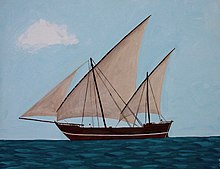lateen
Jump to navigation
Jump to search
English
[edit]
Etymology
[edit]Pronunciation
[edit]- (UK) IPA(key): /ləˈtiːn/
Audio (Southern England): (file) - (US) IPA(key): /læˈtiːn/, /ləˈtin/
- Rhymes: -iːn
Noun
[edit]lateen (plural lateens)
- (nautical) A triangular fore-and-aft sail set on a boom in such way that the tack is attached to the hull of the vessel and the free end of the boom lifts the sail.
- 1853, Henry Coleman Folkard, The Sailing Boat: A Description of English and Foreign Boats[1], page 75:
- The shape of the lateen sail is triangular, or precisely that of a large fore-sail; it requires a long tapering yard to spread it, which will slightly bow or bend towards the middle when a stiff breeze fills the sail; a boom is used for some lateen sails, but not for all.
- 1976, Barbara M. Kreutz, “Ships, Shipping and the Implications of Change in the Medieval Mediterranean”, in Henrik M. Birnbaum, Patrick K. Ford, Hnry Ansgar Kelly, Richard H. Rouse, Speros Vryonis, Jr., Lynn White, Jr., editors, VIATOR: Medieval and Renaissance Studies, Volume 7, University of California Press, page 82:
- Not only is its supporting and controlling rigging best suited to that sail position but, even more important, the sail itself thus presents a rigid leading-edge: the mast, in the case of most modern sailboats, or the yardarm to which the sail is attached, in the case of the medieval Mediterranean lateen or the modern Sailfish.
Fore-and-aft rigs come in a variety of shapes, but the medieval Mediterranean lateen was triangular, and this too was an asset.
- 1990, Richard W. Unger, The Ship in the Medieval Economy 600-1600, page 47:
- The lateen sail is triangular or a quadrilateral which is almost triangular, the former being the type used by the Byzantines.
- 1995, George F. Hourani, John Carswell, Arab Seafaring in the Indian Ocean in Ancient and Early Medieval Times, Princeton University Press, Expanded Edition, page 103,
- The mere fact that this type of lateen no longer exists in the Mediterranean proves nothing; it is always possible that it might have originated there and later given way there to the still superior triangular form. But there are more substantial reasons for believing that the lateen came from the Indian Ocean to the Mediterranean. The earliest evidence of the existence of lateens in the Mediterranean is in Greek Byzantine manuscripts of the late ninth century, which show drawings of lateens (Plates 5 and 6).
Translations
[edit]sail
|